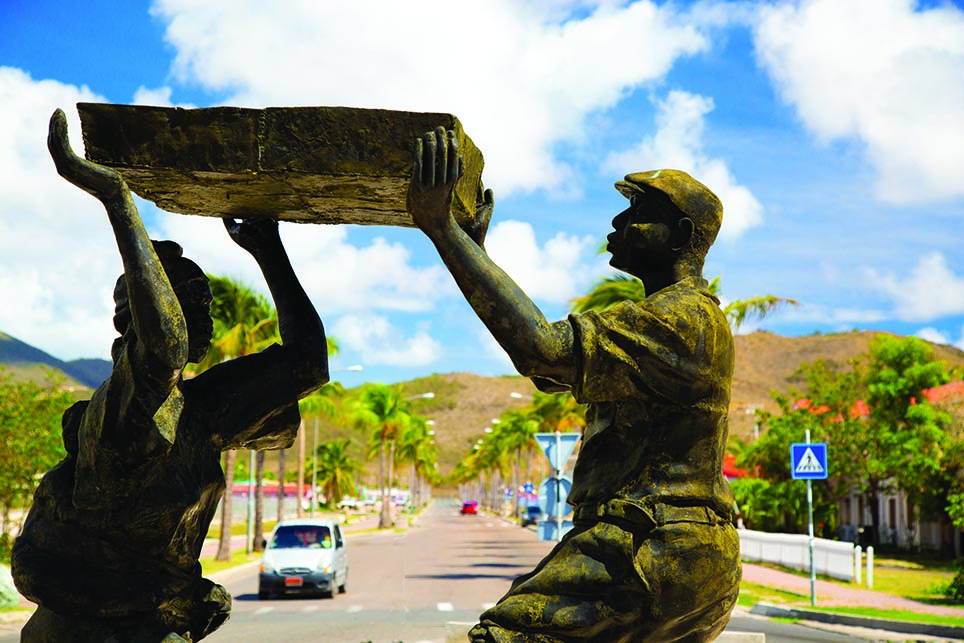SCULPTED TALES
Unveiling the stories behind St. Maarten/St. Martin’s roundabout statues.
By Daniella De Windt
While driving around the beautiful island, you are bound to encounter various roundabouts adorned with bronze statues, each telling a different chapter of St. Maarten/St. Martin’s rich history and culture.
Chances are you have already seen the first statue shortly after arriving on the island. Three bronze sculptures depicting St. Maarten/St. Martin’s national bird, the “Brown Pelicans” welcome visitors at the Princess Juliana International Airport. The airport roundabout also showcases several three letter International Air Transport Association (IATA) codes to honor all the associated hub partner islands, such as Anguilla, Dominica, British Virgin Islands, Saba, St. Eustatius, St. Barths, and Nevis. In 2017, Hurricane Irma destroyed parts of the statues. Fortunately, the sculptures were restored to their former glory in June 2021, thanks to Jim and Janet Eddins, a generous couple from Blairsville, Atlanta.
You will find another popular statue group on your way to Philipsburg, the capital of the Dutch side. On the Pondfill, overlooking the Great Salt Pond, the “Salt Pickers” symbolize an important chapter of St. Maarten/St. Martin’s history as “Soualiga,” land of the salt. When the Dutch colonized the island, they discovered salt in the Great Pond. The settlers forced enslaved men, women, and children to do the physically demanding work of harvesting salt, before shipping cargo ships full of the white gold across the Atlantic. The sculptures represent those enslaved workers. On the roundabout, you will see a man shoveling salt, two women collecting the salt, and a man and a woman with a child on her back carrying a big tray of salt over their heads.
A little further down the same road, toward the port, another statue reminds passersby of the island’s storied past. The “Freedom Fighter” is dedicated to those who fought for emancipation and liberty, building a foundation of freedom for the many generations to come. On the Dutch side, slavery was abolished in 1863, 15 years after abolition on the French side of the island. Every year, during the annual Emancipation Day celebrations on July 1, a commemorative wreath-laying ceremony takes place on this roundabout.
One-Tété Lohkay, a runaway enslaved young woman who has become a legend, was one of those freedom fighters. Her bravery is captured by a statue on the roundabout in front of the St. Maarten Medical Center in Belair. Here, you will see the female freedom fighter in action, running with sugar canes on her left shoulder. If you look closely, you can tell that one side of her chest is deformed. Lohkay was enslaved on a plantation on the southern part of the island. When she tried to escape, she was hunted down by her plantation owners, recaptured, and brought back to the plantation. As punishment for her defiance and as a warning to other enslaved people, the plantation owners ordered that one of her breasts be cut off. But this did not deter the brave woman; she recovered and escaped again, this time remaining free and secretly visiting plantations in search of food.
Renowned Nigerian-born local sculptor Michael Maghiro made most of the bronze statues on the island. Steeped in the tradition of the Benin masters, his bronze sculptures can be found across the Caribbean, as well as in the United States and in various African countries. Maghiro believes that his statues help tell St. Maarten/St. Martin’s story. “It is good to remember where we came from, and it is important to celebrate our local heroes,” he says. His statues serve as poignant reminders of the island’s rich history, cultural heritage, and the enduring spirit forged through past struggles.
More blogs on Culture & Arts
Back to the Visit St Maarten Main page

